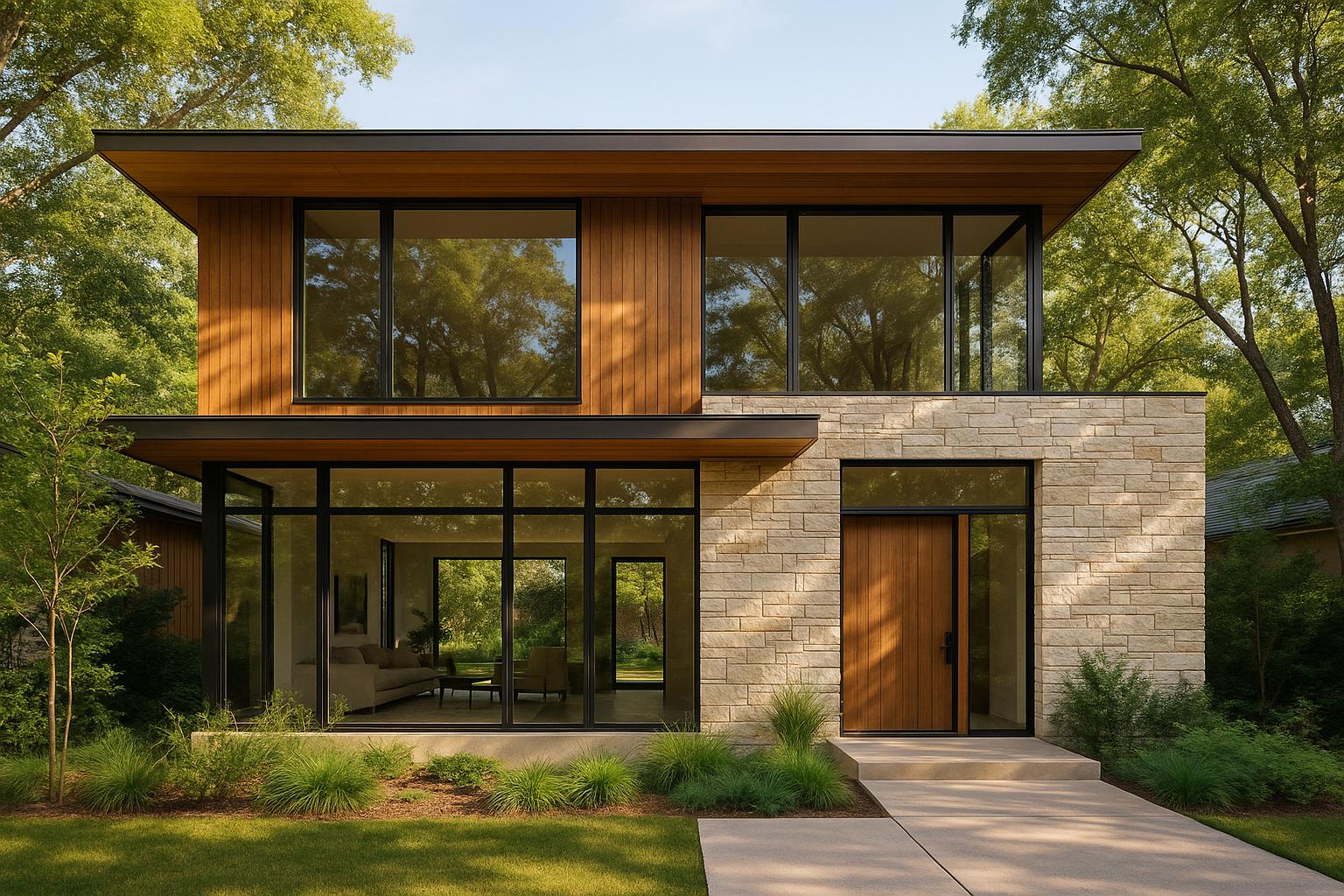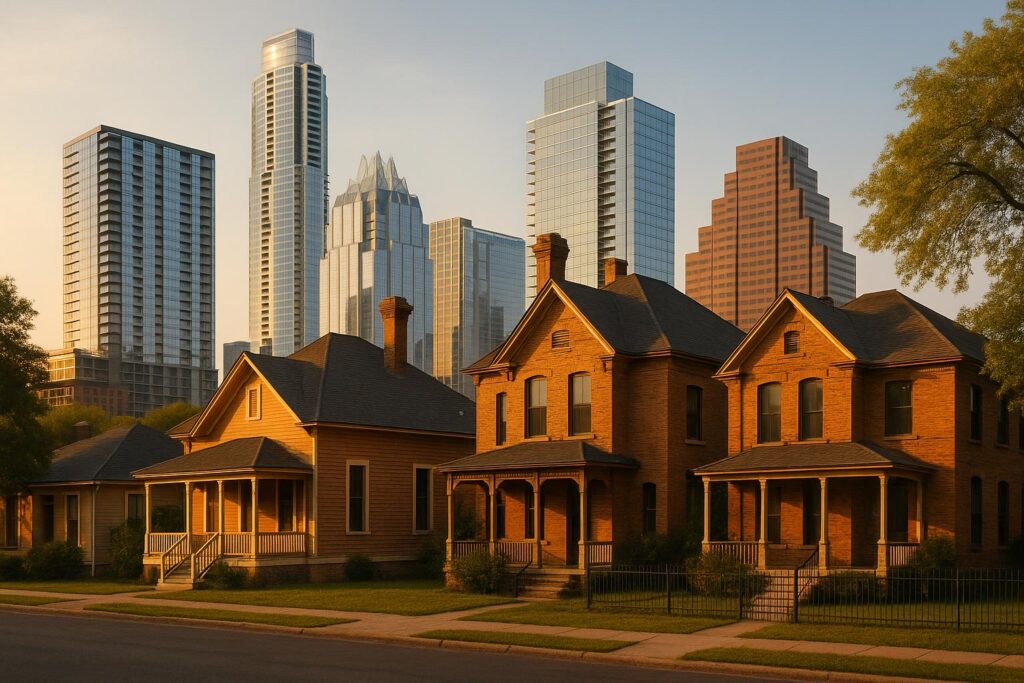Austin homes are embracing a shift toward natural materials like reclaimed wood, local limestone, and raw steel. These materials not only reflect the city’s character but also offer durability and energy efficiency suited to the region’s climate. From the Barton Hills Residence to the Clarksville Urban Cottage, each property highlights unique ways of blending design with nature. Key trends include:
- Locally Sourced Materials: Texas limestone, reclaimed cedar, and native stone.
- Energy-Saving Features: Solar panels, geothermal systems, and rainwater collection.
- Biophilic Design: Seamless indoor-outdoor transitions, natural light, and greenery.
Below, we explore 10 standout homes that redefine how natural elements enhance modern living in Austin.
HOUSE TOUR | Inside a Home Hugged By Nature in Austin, Texas
1. Barton Hills Residence
Situated in one of Austin’s most sought-after neighborhoods, the Barton Hills Residence is a masterclass in the use of natural materials. Designed by Alterstudio Architecture, this home earned a Commendation for "Command of Materiality" at the 2024 AIA Austin Design Awards. The recognition highlights how carefully chosen materials can create a design that naturally evolves and matures with its surroundings.
Use of Natural Materials
The home’s materials – wood, native stone, Corten steel, and board-formed concrete – were selected not just for their aesthetic appeal but for how they transform over time. Key design elements include a sculpted entry wall, a gracefully curving board-formed concrete landscape wall, and a Corten steel gate that develops a rich, rusted patina as it weathers.
"The exterior wood, stone, Corten steel, and board-formed concrete are intended to mature gracefully along with the surrounding landscape." – alterstudio
This harmony between the exterior and interior design is seamless. Inside, white oak flooring adds warmth, while walls finished with Tadelakt plaster – a traditional technique that creates smooth, water-resistant surfaces – maintain a sense of understated elegance.
Design Elements Promoting Biophilic Living
The home’s layout goes beyond materials to foster a deep connection with nature. The interior spaces mirror the organic transitions of the exterior, creating a sense of flow and continuity. A standout feature is the curved, double-sided reading nook recessed into the concrete wall, offering a cozy space that feels intimately connected to the outdoors.
Principal Kevin Alter captures the essence of the design:
"We let weathering imbue the house with character. So it’s not overtly shouting, ‘look at me.’" – Kevin Alter, Principal, Alterstudio Architecture
This intentional design philosophy ensures the Barton Hills Residence will age gracefully, blending ever more deeply with its natural surroundings while continuing to stand out for its quiet sophistication.
2. Zilker Modern Retreat
Nestled just a stone’s throw from Austin’s famous Zilker Park, the Zilker Modern Retreat is a contemporary gem that merges sleek design with eco-conscious living. This home strikes a perfect balance between modern comforts and thoughtful environmental practices, creating a space that feels both stylish and responsible.
Natural Materials That Reflect Austin’s Character
The exterior of the home harmonizes with its surroundings through a mix of natural stone and reclaimed wood siding, echoing the textures of the local landscape. Step inside, and you’ll find hardwood floors and textured plaster walls that exude warmth and sophistication. The kitchen is a standout, featuring natural stone countertops and custom cabinetry made from locally sourced wood. These design choices honor Austin’s rich design traditions while embracing its evolving aesthetic.
Energy Efficiency at Its Core
The Zilker Modern Retreat is a model of energy-efficient living, perfectly aligned with Austin’s sustainability goals. A geothermal heating and cooling system provides a smarter alternative to conventional systems, while solar panels generate a significant portion of the home’s energy needs. High-performance windows and advanced insulation ensure year-round comfort by keeping the indoor climate steady, no matter the season. Every element is designed to work in harmony with Austin’s unique climate.
Designed for Austin’s Climate and Landscape
The home’s thoughtful design makes it well-suited for Austin’s sunny summers and mild winters. Deep overhangs provide shade during the hot months while allowing sunlight to flood the interiors in winter. A green roof, planted with native vegetation, not only supports local wildlife but also helps manage stormwater runoff. The addition of a rainwater collection system further enhances the home’s efficiency and connection to the local environment.
Bringing Nature Indoors
The retreat also embraces biophilic design principles, creating a seamless connection between indoor and outdoor spaces. Sliding glass doors open up the home to the outdoors, making the most of Austin’s pleasant weather. A living wall in the entryway adds a touch of greenery while improving air quality, and strategically placed skylights fill the home with natural light that shifts beautifully throughout the day. These features make the home feel alive, blending modern living with the tranquility of nature.
3. Westlake Eco-Haven
Blending environmental awareness with the charm of its surroundings, Westlake Eco-Haven stands as a striking example of thoughtful design. Nestled in the scenic hills of Westlake, this home highlights the beauty of natural craftsmanship.
Use of Natural Materials
The exterior of the home features locally quarried limestone, mirroring the rugged rock formations native to the area. Adding to its character, reclaimed cedar siding – sourced from historic Texas barns – brings a sense of warmth and history to the facade.
Step inside, and you’ll find wide-plank oak flooring stretching across the main living areas. The kitchen boasts Carrara marble countertops paired with custom cabinetry crafted from locally sourced walnut. Meanwhile, the master bathroom showcases a travertine accent wall, adding a touch of elegance and texture to the space.
4. Rosedale Urban Oasis
Tucked away in one of Austin’s most beloved neighborhoods, the Rosedale Urban Oasis beautifully combines historic charm with forward-thinking, eco-conscious design. This home showcases how using natural materials and sustainable practices can elevate both aesthetics and functionality.
Natural Materials with Local Flair
The home’s design features an array of natural materials that pay homage to the local environment. From stone accents to reclaimed wood finishes, every detail exudes warmth and reflects the beauty of the surrounding landscape. These thoughtful choices not only enhance the home’s character but also contribute to practical solutions for energy efficiency and comfort.
Smart Energy and Eco-Conscious Features
Built with sustainability in mind, the home incorporates energy-efficient insulation, a cutting-edge HVAC system, and water-saving fixtures. These features work together to reduce its environmental impact while ensuring a cozy, comfortable living space year-round.
Harmonizing with the Landscape
The design seamlessly integrates with Austin’s natural surroundings. Expansive windows and carefully planned overhangs allow for a perfect balance of sunlight and shade, while the landscaping – featuring drought-resistant native plants – reflects an understanding of the local climate and the importance of water conservation.
A Home That Brings Nature In
Biophilic design principles shine throughout the space, with ample natural light, lush greenery, and smooth transitions between indoor and outdoor areas. This thoughtful approach not only enhances the home’s visual appeal but also fosters a tranquil, nature-centered living experience that promotes well-being.
5. Bouldin Creek Craftsman
The Bouldin Creek Craftsman home is a beautiful blend of classic Craftsman design and eco-conscious living. By combining traditional aesthetics with sustainable choices, it creates a space that’s both timeless and environmentally mindful. Let’s dive into the elements that define its charm.
Use of Natural Materials
The exterior of this home pays homage to classic Craftsman style, featuring a thoughtful combination of stone accents and wood siding that gives it a warm, textured look. Inside, the use of carefully chosen wood finishes and reclaimed materials brings a sense of history and character, balancing vintage charm with a modern touch.
Energy Efficiency Features
This home doesn’t just look good – it’s smart, too. With natural thermal materials and integrated renewable energy solutions, it keeps indoor temperatures comfortable while cutting down on energy consumption.
Integration with Austin’s Landscape and Climate
Built with Austin’s unique climate in mind, the design incorporates well-placed overhangs and windows to maximize natural light and cooling. Outside, native, drought-resistant plants create a low-maintenance landscape that conserves water without sacrificing beauty.
Design Elements Promoting Biophilic Living
The layout encourages a seamless connection to nature. An open floor plan and large windows invite the outdoors in, while a central courtyard offers a peaceful, private escape. This thoughtful design enhances natural airflow and brings a calming, nature-inspired vibe to the home.
6. Allandale Contemporary
Nicknamed the Canopy House, this standout property in Allandale gained acclaim by winning the 2019 American Architecture Award. Designed by the team at A Parallel Architecture, it merges contemporary style with Austin’s natural beauty, using materials and design elements that feel at home in the environment.
Thoughtful Use of Natural Materials
The Canopy House showcases a warm, inviting exterior with mahogany siding and a pine roof, while the interior mirrors this aesthetic with mahogany-framed windows and custom cabinetry for a seamless flow throughout the home.
"To further incorporate the house into the landscape, which includes bamboo and crepe myrtles in the backyard and xeriscaping in the front, the architects used as much natural wood and stone as possible, including Jerusalem Bone Limestone in the bathrooms and on the patio, mahogany for the siding, windows, and cabinets, and pine for the roof." – Erin Quinn-Kong, Austin Home
Inside and out, Jerusalem Bone Limestone adds a touch of elegance and durability, appearing in the bathrooms and on the patio. These carefully chosen materials not only elevate the home’s design but also ensure it stands the test of time.
Built to Last
Durability was a key focus for the Canopy House. By selecting high-quality, sustainable materials, the architects aimed to create a home that requires minimal upkeep and maintains its integrity over decades.
"Our houses are built to last, so they don’t need to be restored ever." – Eric Barth, Co-owner of A Parallel Architecture
A Home Rooted in Its Environment
The design of the Canopy House is deeply tied to Austin’s landscape. From the xeriscaping in the front yard to the bamboo and crepe myrtles in the back, the home feels like a natural extension of its surroundings. The architects embraced the area’s topography and vegetation, ensuring the house blends seamlessly into its environment.
Connecting Indoors and Outdoors
Biophilic design principles shine through in features like the large mahogany-framed windows, which flood the interiors with natural light and offer stunning views of the landscape. The limestone patio further enhances this connection, extending the living space outdoors and creating a harmonious flow between indoor and outdoor living areas. This thoughtful integration invites residents to feel more connected to nature without ever leaving home.
sbb-itb-4c99469
7. Tarrytown Midcentury Revival
This Tarrytown midcentury modern home beautifully blends the clean, geometric lines of classic 1960s design with a fresh focus on natural accents. It’s a nod to Austin’s love for organic materials, offering a harmonious mix of timeless style and eco-friendly updates. Here’s a closer look at how this home brings midcentury charm into the modern era.
Embracing Natural Materials
The exterior features materials that echo the textures of the local landscape, creating a connection to the surrounding environment. Inside, the warm, earthy tones align with Austin’s preference for designs that feel organic and sustainable. This thoughtful use of materials bridges the gap between midcentury tradition and today’s environmental considerations.
Smart Design for Comfort and Sustainability
The home takes full advantage of natural light and shade, thanks to its large windows, extended overhangs, and landscaping with native, drought-resistant plants. These elements not only enhance comfort but also highlight a commitment to sustainable living while maintaining a strong connection to the outdoors.
Indoor–Outdoor Harmony
One of the home’s standout features is its seamless integration of indoor and outdoor spaces. Wide openings and a carefully designed outdoor area invite sunlight and fresh air into the living spaces, creating a welcoming, airy atmosphere. This design celebrates Austin’s outdoor lifestyle, making the home feel like an extension of its natural surroundings.
8. Travis Heights Treehouse
The Travis Heights Treehouse is a stunning example of blending natural elements with sleek, modern design. Built on a sturdy stone foundation and accented with warm wood details, this home feels like a true escape into nature. Large windows and open interiors flood the space with natural light and invite in refreshing breezes, creating the perfect treehouse-like atmosphere. Beyond its beauty, the thoughtful combination of stone and wood reflects Austin’s dedication to stylish and eco-conscious living.
9. Mueller Green Home
Mueller Green Home takes Austin’s passion for eco-conscious living to the next level, offering a perfect blend of luxury and sustainability. Nestled in the Mueller neighborhood, this home showcases how thoughtful design can harmonize natural materials with energy-smart systems.
Use of Natural Materials
This home incorporates locally sourced stone and reclaimed wood in its architecture, both inside and out. These elements give the space a warm, earthy feel while highlighting a commitment to mindful building practices.
Energy Efficiency Features
The home is equipped with renewable energy solutions, advanced climate control systems, and eco-friendly insulation. These features work together to minimize energy use and lower the home’s environmental impact.
Integration with Austin’s Landscape and Climate
Designed with Austin’s unique environment in mind, the home includes extended overhangs to provide shade and natural cooling. A rainwater collection system further supports native landscaping, ensuring the property thrives in harmony with its surroundings.
Design Elements Promoting Biophilic Living
With expansive windows and inviting outdoor spaces, the home blurs the line between indoors and out. Natural light floods the interior, while covered patios encourage a closer connection to nature, making the space both beautiful and serene.
10. Clarksville Urban Cottage
The Clarksville Urban Cottage continues Austin’s tradition of combining eco-conscious design with a deep appreciation for local character. This beautifully renovated home strikes a balance between historic charm and modern sustainability. By carefully choosing natural materials, it transforms a compact urban space into a peaceful haven while staying true to its architectural roots.
Embracing Natural Materials
This cottage showcases a thoughtful use of natural materials, blending locally sourced stone with reclaimed wood accents. The design leans into earthy textures and subtle, neutral finishes that reflect the neighborhood’s historic vibe without overcomplicating the aesthetic.
Energy-Saving Features
The home incorporates low-VOC finishes alongside energy-efficient HVAC systems and windows. Together, these features create a comfortable indoor environment while reducing the home’s environmental footprint.
Tailored for Austin’s Climate and Landscape
Designed with Austin’s unique climate in mind, the cottage features a xeriscaped garden filled with native trees that provide shade and conserve water. Spacious porches and cross-ventilation enhance the connection between indoor and outdoor spaces, making the home well-suited for year-round enjoyment.
A Nod to Biophilic Living
The design goes a step further by fostering a strong connection to nature. Large sliding doors open to a private courtyard, seamlessly blending indoor and outdoor living. Additional touches like a calming water feature, abundant skylights, and a living wall bring the outdoors into the heart of the home, creating a tranquil and inviting atmosphere.
Home Comparison Table
We’re preparing a comprehensive table to summarize key details for all the featured properties. Once finalized, it will showcase trends in the use of natural materials and energy-conscious designs across some of Austin’s most forward-thinking homes.
The table will include specifics on natural materials, energy efficiency, and standout design elements. Stay tuned – updates will be added as soon as we verify the data.
Conclusion
"Austin pioneered green building in America, establishing the nation’s first sustainable building program in 1990." – newhousebuilder.com
From the charming neighborhoods of Barton Hills to the historic streets of Clarksville, Austin’s homes stand as perfect examples of how sustainability and luxury can coexist. These residences highlight a thoughtful blend of eco-conscious practices and modern comforts. Locally sourced limestone and reclaimed wood reflect Central Texas’s rich heritage, while advanced technologies like solar panels have demonstrated energy savings of up to 70%. It’s a clear testament that going green doesn’t mean compromising on elegance.
Builders like Jenkins Design Build are leading the charge, recycling 80% of construction waste while crafting stunning homes in sought-after areas like Westlake, Barton Creek, and Lake Travis. Similarly, projects such as Matt Fajkus Architecture‘s Inverse House showcase the seamless integration of materials like Texas limestone, white oak, and stained maple cabinetry, proving that sustainability can also be strikingly beautiful.
For those inspired by these designs, you don’t need to start from scratch to embrace sustainable living. Simple updates like adding locally sourced stone accents, reclaimed wood features, or native landscaping can make a big impact. These changes not only enhance your home’s aesthetic but also help conserve water and connect your living space to the natural beauty of Central Texas. Smart upgrades like energy-efficient windows and home automation systems can further reduce energy consumption while modernizing your space.
If you’re looking to take the next step toward a greener lifestyle, Austin Local Team can help. Their expert agents specialize in finding properties that prioritize eco-friendly features, such as bamboo flooring, recycled steel, and low-VOC finishes. Whether you’re interested in solar-powered homes, rainwater harvesting systems, or designs that emphasize natural light and indoor-outdoor harmony, their personalized approach ensures you’ll find a home that aligns with your values. In a city celebrated for its environmental consciousness, making sustainable choices has never been easier.
FAQs
How do materials like reclaimed wood and local limestone improve energy efficiency in Austin homes?
Natural materials like reclaimed wood and locally sourced limestone are making a big impact on energy-efficient home designs in Austin. Limestone, with its impressive thermal mass, naturally helps keep indoor temperatures steady. It absorbs heat during the day and releases it slowly at night, cutting down on the need for constant heating or cooling. Reclaimed wood, on the other hand, offers natural insulation, helping to maintain a cozy indoor environment while reducing energy use.
Beyond their practical benefits, these materials fit perfectly with Austin’s commitment to eco-friendly home design. By relying less on mechanical systems for temperature control, they promote a more sustainable approach to building.
What is biophilic design, and how do Austin homes use it to create healthier living spaces?
Biophilic design is all about bringing elements of nature – like natural light, greenery, and organic materials – into indoor spaces. The goal? To create a deeper connection to the natural world, which has been shown to ease stress, boost mood, and support overall well-being.
In Austin, many homes are embracing this concept by incorporating materials such as wood, stone, and natural fibers. They also prioritize maximizing sunlight and adding plenty of plants. These design choices not only enhance the visual appeal of a home but also contribute to a healthier, more balanced living space.
How can homeowners easily add natural materials and adopt sustainable practices in their homes?
Looking to give your home a fresh look while keeping it eco-conscious? Consider incorporating natural materials like bamboo, reclaimed wood, cork, or recycled glass. Whether used for flooring, countertops, or decorative accents, these options not only reduce environmental impact but also add a cozy, inviting touch to your space.
For a greener and more energy-efficient home, small updates can go a long way. Boost insulation, seal drafty windows and doors, or switch to LED lighting and ENERGY STAR® appliances. These changes not only cut down on energy use and waste but also make your home more comfortable and cost-effective in the long run.





